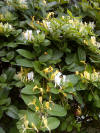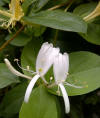WILD
FOODIES' HOME PAGE
PLANT PROFILE LIST
NAME: Japanese honeysuckle
SPECIES / FAMILY: Lonicera Japonica / Caprifoliaceae
OTHER COMMON NAME(S):
CONDITIONS:
sun/partial shade
|
PARTS: |
EDIBLE |
TASTE |
RAW/COOK |
SEASON |
|
All |
|
|
|
|
|
Shoots |
|
|
|
|
|
Leaves |
|
BOIL 2x |
Spring |
|
|
Stalk/Stem |
|
|
|
|
|
Buds |
||||
|
Flowers |
|
sweet |
RAW/COOK |
Summer |
|
Fruits |
|
|
|
|
|
Pods |
|
|||
|
Seeds |
|
|
|
|
|
Nuts |
|
|
|
|
|
Roots |
|
|
|
|
|
Bark |
|
|
|
|
PORTION: small
COMMENT: Japanese honeysuckle is the most common Honeysuckles species, which is why we should know its many uses! // Leaves - cooked. The parboiled leaves are used as a vegetable. Flowers - sucked for their sweet nectar, used as a vegetable or made into a syrup and puddings.(1)
CAUTION: The leaves contain saponins. Saponins are quite toxic but are poorly absorbed by the human body and so most pass through without harm. They can be found in many common foods such as some beans. Thorough cooking, and perhaps changing the cooking water once, will normally remove most of the saponins.(1)
There are about 180 species of honeysuckle, most native to the northern hemisphere. The greatest number of species is in China with over 100. North America and Europe have only about 20 native species each, and the ones in Europe are usually toxic. Taste is not a measure of toxicity. Some Lonicera have delicious berries that are quite toxic and some have unpalatable berries that are not toxic at all. This is one plant on which taste is not a measure of edibility. Properly identify the species. ... Among the edible are: L. affinis, flowers and fruit; L. angustifolia, fruit; L. caprifolium, fruit, flowers to flavor tea; L. chrysantha, fruit; L. ciliosa, fruit, nectar; L. hispidula, fruit; L. involucrata, fruit; L. kamtchatica, fruit; L. Japonica, boiled leaves, nectar; L. periclymenum, nectar; L. utahensis, fruit; L. villosa, fruit; L. villosa solonis, fruit; (2) https://www.eattheweeds.com/honeysuckle-heaven-2/
Lesser known native species:
-
https://gobotany.newenglandwild.org/species/lonicera/canadensis
-
https://en.wikipedia.org/wiki/Diervilla_lonicera
NUTRITION/MEDICINAL:
- https://draxe.com/nutrition/honeysuckle
- https://www.webmd.com/vitamins/ai/ingredientmono-512/honeysuckle
- Antibacterial; Anti-inflammatory; Antispasmodic; Antiviral; Depurative; Diuretic; Febrifuge; Skin; TB; VD.(1)
LOOK-A-LIKES: https://pfaf.org/user/Plant.aspx?LatinName=Lonicera+periclymenum
POISONOUS LOOK-A-LIKES: There are several deadly honeysuckles, so make sure you have the safe-to-eat, such as the most common, Japanese Honeysuckle (Lonicera japonica).(4) Not noted as poisonous, but also not noted as edible - https://pfaf.org/user/Plant.aspx?LatinName=Lonicera+sempervirens
OTHER USES: Basketry, papermaking, cordage - https://www.matttommey.com/basket-weaving-techniques/how-to-weave-a-basket-with-honeysuckle / Insecticide.(1) Nectar source for bees & butterflies (4)
SOURCE LINKS (may include nutritional and medicinal info, plus other uses):
- https://pfaf.org/user/Plant.aspx?LatinName=Lonicera+japonica
- http://www.eattheweeds.com/honeysuckle-heaven-2
- https://en.wikipedia.org/wiki/Lonicera_japonica
- http://www.foragingtexas.com/2008/11/japanese-honeysuckle.html (good photos)
- https://www.healthygreensavvy.com/honeysuckle-recipes
- https://theviewfromgreatisland.com/honeysuckle-iced-tea-2
- https://www.primallyinspired.com/how-to-make-honeysuckle-tea
- https://theherbalacademy.com/homemade-honeysuckle-syrup
- https://www.wikihow.com/Eat-Honeysuckle
- https://everythingbackyard.net/how-to-eat-honeysuckle
- https://homespunseasonalliving.com/using-honeysuckle-for-food-and-medicine
- https://foragingguru.com/honeysuckle-edible
- https://www.wildfoodie.co.uk/post/common-honeysuckle-identification
- https://recipes.net/articles/how-to-eat-honeysuckle

